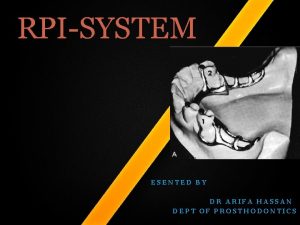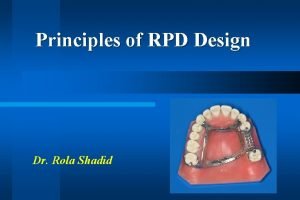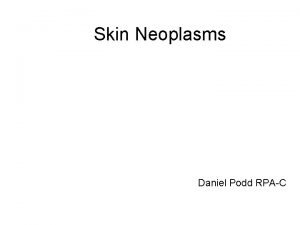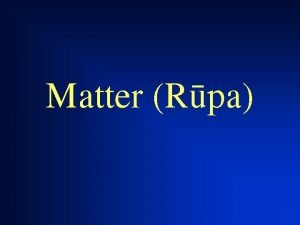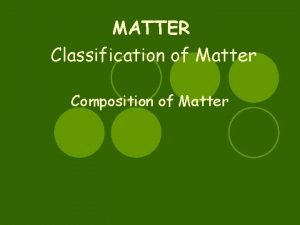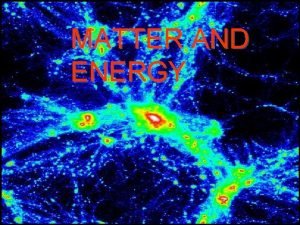The rd 3 UltimateTruth Matter Rpa Why is




































- Slides: 36

The rd 3 Ultimate-Truth Matter (Råpa)

Why is Råpa so called? • Råpa is so called because it is deformed, oppressed, broken by adverse physical conditions such as heat, cold, wind, sunburn, hunger, thirst, poison, by flies, mosquitoes, snake and so on.

Matter is 2 folds • Great elements (Mah -bhåta) – 4 • Derived materiality (Up d ya-råpa) – 24

Life-span of Råpa = 17 Mind-moments Råpa (matter) arising static dissolution


Råpa Kalàpa Arise together Cease together 1. Earth element 2. Water 3. Fire 4. Wind 5. Colour 6. Smell 7. Taste 8. Nutritive Essence Same common base

Why Necessary to Know Matter? • The Buddha: “A bhikkhu understands as it really is: ‘All materiality of whatever kind consists of the four great elements and materiality derived from the four great elements. ’” And The Buddha says that without this knowledge, the bhikkhu is incapable of growth, increase, and fulfillment in this Dhamma and Vinaya.

4 Great Elements 1. Earth Elements (pathavã-dhàtu) 2. Water Elements (àpo-dhàtu) 3. Fire Elements (tejo-dhàtu) 4. Wind Elements (vàyo-dhàtu)

Earth Element • Characteristic = hardness • Function = to act as a support or foundation for the coexisting material phenomena • Manifestation = as receiving coexisting material phenomena • Proximate cause = the other 3 great elements

Water Element • Characteristic = flowing. • Function = to intensify the coexisting matter • Manifestation = as the holding together or cohesion of coexisting matter • Proximate cause = the other 3 great elements

Fire Element • Characteristic = heat or cold. • Function = to matures or ripens coxeisting material phenomena. • Manifestation = as a continuous supply of softness. • Proximate cause = the other 3 great elements • Four components of body in which fire element is predominant. 1. Heat that warms the body 2. Heat that causes maturing and ageing 3. Heat of fever 4. Digestive heat

Wind Element • Characteristic = supporting. • Function = to cause motion and movement in the other materiality. • Manifestation = as conveying to other places. • Proximate cause = the other 3 great elements

six types of wind In our body 1. Wind that moves upwards, causing belching, coughs, sneezing and related illness. 2. Wind that moves downwards, causing bowel movement and frequent motion. 3. Wind that moves about in the visceral cavity, apart from the large and small intestines. 4. Wind that moves about inside the large and small intestines. The wind which is in the intestines, push down the food that is eaten 5. Wind that moves within the limbs. 6. Wind inhaled and exhaled by us.

How 4 elements co-exist? • The 4 great elements are founded upon the earth element, held together by the water element, maintained by the fire element, and distended by the wind element.

28 kinds of Materiality 18 Real Materiality 10 Non-real materiality (Concretely Produced Materiality) (Non-concretely Produced Materiality)

18 Real (Concretely Produced) Materiality 4 Great Elements 5 Sensitive Materiality Eye – Ear – Nose- Tongue – Body 4 Objective Materiality Colour – Sound- Smell – Taste 2 Sex Materiality Masculinity – Femininity 1 Heart Base 1 Life Faculty 1 Nutritive Essence

Pure Octad Kalàpa 1. Earth element 2. Water 3. Fire 4. Wind 5. Colour 6. Smell 7. Taste 8. Nutritive Essence

5 Sensitive Materiality Eye Sensitivity (Cakkhu-pasāda) • The sensitivity of primary elements that is ready for the impact of visible object. • The sensitivity substance in the retina that registers color or light. • It serves as a physical base for eyeconsciousness.

Eye Decad Kalàpa 1. Earth element 2. Water 3. Fire 4. Wind 5. Colour 6. Smell 7. Taste 8. Nutritive Essence 9. Life Faculty 10. Eye sensitivity

Ear Sensitivity (Sota-pasāda) • The sensitivity of primary elements that is ready for the impact of sound. • It is the sensitivity substance found inside the ear hole that registers sound. • It serves as physical base for ear consciousness.

Ear Decad Kalàpa 1. Earth element 2. Water 3. Fire 4. Wind 5. Colour 6. Smell 7. Taste 8. Nutritive Essence 9. Life Faculty 10. Ear sensitivity

Nose Sensitivity (Ghāna-pasāda) • The sensitivity of primary elements that is ready for the impact of smell. • It is the sensitivity substance found inside the nose that registers smell. • It serves as physical base for nose consciousness.

Nose Decad Kalàpa 1. Earth element 2. Water 3. Fire 4. Wind 5. Colour 6. Smell 7. Taste 8. Nutritive Essence 9. Life Faculty 10. Nose sensitivity

Tongue Sensitivity (Jivhā-pasāda) • The sensitivity of primary elements that is ready for impact of taste. • It is the sensitive substance found diffused over the tongue that registers taste. • It is the physical base for tongue consciousness.

Tongue Decad Kalàpa 1. Earth element 2. Water 3. Fire 4. Wind 5. Colour 6. Smell 7. Taste 8. Nutritive Essence 9. Life Faculty 10. Tongue sensitivity

Body Sensitivity (kāya-pasāda) • The sensitivity of primary elements that is ready for impact of tangible objects. • It extends all over the body that is sensitive to touch or tangible object. • It serves as a physical base for body consciousness.

Body Decad Kalàpa 1. Earth element 2. Water 3. Fire 4. Wind 5. Colour 6. Smell 7. Taste 8. Nutritive Essence 9. Life Faculty 10. Body sensitivity

4 Objective Materiality (Colour – Sound- Smell – Taste) 1. Colour : (a) Characteristic = impinge eye sensitivity. (b) Function = to be the object of eye consciousness and mental factor associated with it. 2. Sound: (a) Characteristic = impinge ear sensitivity. (b) Function = to be the object of ear consciousness and mental factor associated with it. 3. Smell: (a) Characteristic = impinge nose sensitivity. (b) Function = to be the object of nose consciousness and mental factor associated with it. 4. Taste: (a) Characteristic = impinge tongue sensitivity. (b) Function = to be the object of tongue consciousness and mental factor associated with it.

2 Sexual Phenomena (bhàva-råpa) Female faculty • to show that “this is female”. • It manifests through the mark, sign, work, and ways of the female. • It is found all over the body.

Male Faculty • To show that “this is a male”. • It manifests through marks, sign, work and the ways of the male. • It is found all over the body.

2 Sexual Phenomena Male Sexual Decad Kalàpa Female Sexual Decad Kalàpa 1. 2. 3. 4. 5. 6. 7. 8. 9. 10. Earth element Water Fire Wind Colour Smell Taste Nutritive Essence Life Faculty Male Faculty Earth element Water Fire Wind Colour Smell Taste Nutritive Essence Life Faculty Female Faculty

Heart-Base (Hadaya-vatthu) • Being the material support for all consciousness except five sense consciousness. • It is found in the blood of the heart. • Each consciousness arises depending on only one heart-base.

Heart Base Decad Kalàpa 1. Earth element 2. Water 3. Fire 4. Wind 5. Colour 6. Smell 7. Taste 8. Nutritive Essence 9. Life Faculty 10. Heart Base

Life Faculty (Jīvitindriya) • It is a vital force in materiality that sustains the life of co-existing ten materiality. • It maintains only kamma-produced materiality, such as eye, ear, nose and so on.

Life Nonad Kalàpa 1. Earth element 2. Water 3. Fire 4. Wind 5. Colour 6. Smell 7. Taste 8. Nutritive Essence 9. Life Faculty

18 Real Matter • Matter possessing intrinsic nature (sabhàva-råpa) • Matter possessing common characteristics (salakkha a-råpa) • As concretely produced matter (nipphanna-råpa) • As to be comprehended by insight (sammasana-råpa)
 Andreas carlsson bye bye bye
Andreas carlsson bye bye bye Dont ask
Dont ask Section 1 composition of matter
Section 1 composition of matter Whats gray matter
Whats gray matter Classification of matter section 1 composition of matter
Classification of matter section 1 composition of matter Chapter 2 section 1 classifying matter answers
Chapter 2 section 1 classifying matter answers Cerebral aqueduct
Cerebral aqueduct Section 1 composition of matter
Section 1 composition of matter Gray matter and white matter
Gray matter and white matter What is grey matter
What is grey matter Ecological succession
Ecological succession Rpa prioritization matrix
Rpa prioritization matrix Enterprise rpa platform
Enterprise rpa platform Rpa system denture
Rpa system denture Beehive datamatics
Beehive datamatics Rpa checklist
Rpa checklist Robotic process automation rfp
Robotic process automation rfp Stress releasing direct retainer
Stress releasing direct retainer Rpa architecture diagram
Rpa architecture diagram Height of contour of tooth
Height of contour of tooth Datamatics rpa
Datamatics rpa Rpa in corporate services
Rpa in corporate services Forrester wave 2017 rpa
Forrester wave 2017 rpa Rpa afsc
Rpa afsc Rpa rastreamento
Rpa rastreamento Ibm rpa vs helpsystems
Ibm rpa vs helpsystems Macro vs rpa
Macro vs rpa What is rpa
What is rpa Tripoding in rpd
Tripoding in rpd Reverse action clasp
Reverse action clasp Rpa vs rpac
Rpa vs rpac Kevin thompson nsf
Kevin thompson nsf Hát kết hợp bộ gõ cơ thể
Hát kết hợp bộ gõ cơ thể Lp html
Lp html Bổ thể
Bổ thể Tỉ lệ cơ thể trẻ em
Tỉ lệ cơ thể trẻ em Voi kéo gỗ như thế nào
Voi kéo gỗ như thế nào













